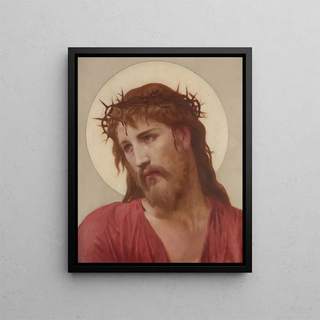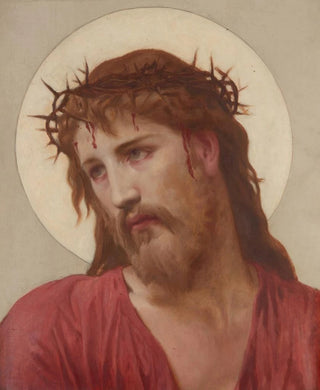Art print | The Crown of Thorns - William Bouguereau


View from behind

Frame (optional)
La couronne d'épines - William Bouguereau – Captivating Introduction
In the rich and complex universe of art, certain works transcend their era to touch the human soul in a timeless manner. "The Crown of Thorns," painted by William Bouguereau, is one of those iconic pieces that evoke both suffering and beauty. This masterful artwork, created at the end of the 19th century, immerses the viewer in an atmosphere of deep reflection, where pain and grace meet. Bouguereau, an undisputed master of realism, manages to capture the very essence of human emotion through meticulous details and impeccable technique, making this piece essential for art enthusiasts.
Style and uniqueness of the work
William Bouguereau's style is distinguished by his ability to blend striking realism with an almost romantic sensitivity. In "The Crown of Thorns," the depiction of Christ, crowned with thorns, is imbued with poignant humanity. The delicate features and warm colors give the figure an aura of serenity, despite the suffering it endures. Light plays a crucial role in this composition, illuminating Christ's face and highlighting the textures of the drapery, while creating an almost celestial atmosphere. Bouguereau excels in rendering emotions, and here, he succeeds in evoking compassion and pain in a way that resonates deeply with the viewer. Every detail, from the gaze filled with sadness to the delicately posed hands, testifies to exceptional craftsmanship and a commitment to emotional truth.
The artist and his influence
William Bouguereau, born in 1825, is one of the most influential artists of his time. His work aligns with the academic movement, but he stands out through a unique approach that combines tradition and innovation. Bouguereau captured the spirit of his era while maintaining a personal sensitivity, allowing him to reach a broad audience. His technical mastery, combined with a deep understanding of human anatomy and light, made him a model for many artists. Although he was criticized by some for his overly academic style, his impact on

Matte finish

View from behind

Frame (optional)
La couronne d'épines - William Bouguereau – Captivating Introduction
In the rich and complex universe of art, certain works transcend their era to touch the human soul in a timeless manner. "The Crown of Thorns," painted by William Bouguereau, is one of those iconic pieces that evoke both suffering and beauty. This masterful artwork, created at the end of the 19th century, immerses the viewer in an atmosphere of deep reflection, where pain and grace meet. Bouguereau, an undisputed master of realism, manages to capture the very essence of human emotion through meticulous details and impeccable technique, making this piece essential for art enthusiasts.
Style and uniqueness of the work
William Bouguereau's style is distinguished by his ability to blend striking realism with an almost romantic sensitivity. In "The Crown of Thorns," the depiction of Christ, crowned with thorns, is imbued with poignant humanity. The delicate features and warm colors give the figure an aura of serenity, despite the suffering it endures. Light plays a crucial role in this composition, illuminating Christ's face and highlighting the textures of the drapery, while creating an almost celestial atmosphere. Bouguereau excels in rendering emotions, and here, he succeeds in evoking compassion and pain in a way that resonates deeply with the viewer. Every detail, from the gaze filled with sadness to the delicately posed hands, testifies to exceptional craftsmanship and a commitment to emotional truth.
The artist and his influence
William Bouguereau, born in 1825, is one of the most influential artists of his time. His work aligns with the academic movement, but he stands out through a unique approach that combines tradition and innovation. Bouguereau captured the spirit of his era while maintaining a personal sensitivity, allowing him to reach a broad audience. His technical mastery, combined with a deep understanding of human anatomy and light, made him a model for many artists. Although he was criticized by some for his overly academic style, his impact on






